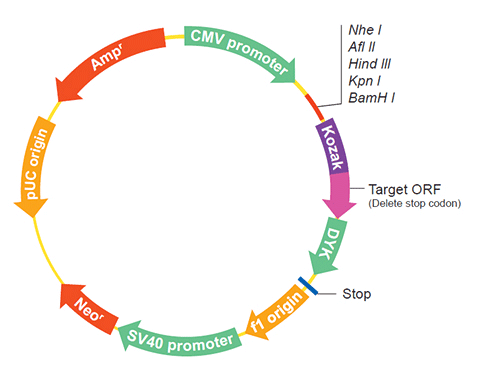| Gene Symbol | KIR2DL6 |
| Entrez Gene ID | 100125360 |
| Full Name | killer cell immunoglobulin-like receptor |
| Gene Type | protein-coding |
| Organism | Pan troglodytes(chimpanzee) |
HOME
ORF » Species Summary » Pan troglodytes » KIR2DL6 cDNA ORF clone
| Gene Symbol | KIR2DL6 |
| Entrez Gene ID | 100125360 |
| Full Name | killer cell immunoglobulin-like receptor |
| Gene Type | protein-coding |
| Organism | Pan troglodytes(chimpanzee) |
| mRNA | Protein | Name |
|---|---|---|
| NM_001104610.1 | NP_001098080.1 | killer cell immunoglobulin-like receptor |
| XM_024353884.1 | XP_024209652.1 | killer cell immunoglobulin-like receptor isoform X1 |

| Pan troglodytes (chimpanzee) | KIR3DS1 | XP_003953668.1 |
| Pan troglodytes (chimpanzee) | KIR2DL6 | XP_003953671.1 |
| KIRDL8 | NP_001098642.1 | |
| KIR3DH5 | NP_001098643.1 | |
| LOC100125568 | NP_001098645.1 | |
| Homo sapiens (human) | KIR3DL2 | NP_006728.2 |
| Pan troglodytes (chimpanzee) | KIR3DL5 | NP_001098079.1 |
| MAMU-KIR | NP_001098025.1 | |
| KIR3DL12 | NP_001098641.1 | |
| KIR3DL21 | NP_001098023.1 | |
| KIR3DL10 | NP_001098640.1 | |
| LOC100125569 | NP_001098646.1 | |
| LOC100424211 | XP_002801535.1 |

Chimpanzees use more varied receptors and ligands than humans for inhibitory killer cell Ig-like receptor recognition of the MHC-C1 and MHC-C2 epitopes.
Moesta AK, Abi-Rached L, Norman PJ, Parham P
Journal of immunology (Baltimore, Md. : 1950)182(6)3628-37(2009 Mar)
Rapid evolution of NK cell receptor systems demonstrated by comparison of chimpanzees and humans.
Khakoo SI, Rajalingam R, Shum BP, Weidenbach K, Flodin L, Muir DG, Canavez F, Cooper SL, Valiante NM, Lanier LL, Parham P
Immunity12(6)687-98(2000 Jun)
GeneRIFs: Gene References Into Functions What's a GeneRIF?
Human natural killer leukemia cells expressing chimpanzee KIR2DL6 receptor cannot kill human carcinoma 221 target cells expressing chimpanzee or human major histocompatibility complex allotypes bearing the inhibitory C1 epitope defined by lysine 44.
Title: Chimpanzees use more varied receptors and ligands than humans for inhibitory killer cell Ig-like receptor recognition of the MHC-C1 and MHC-C2 epitopes.
The following KIR2DL6 gene cDNA ORF clone sequences were retrieved from the NCBI Reference Sequence Database (RefSeq). These sequences represent the protein coding region of the KIR2DL6 cDNA ORF which is encoded by the open reading frame (ORF) sequence. ORF sequences can be delivered in our standard vector, pcDNA3.1+/C-(K)DYK or the vector of your choice as an expression/transfection-ready ORF clone. Not the clone you want? Click here to find your clone.
| CloneID | OPc01561 | |
| Clone ID Related Accession (Same CDS sequence) | NM_001104610.1 | |
| Accession Version | NM_001104610.1 Latest version! | Documents for ORF clone product in default vector |
| Sequence Information | ORF Nucleotide Sequence (Length: 1014bp) Protein sequence SNP |
|
| Vector | pcDNA3.1-C-(k)DYK or customized vector |  User Manual User Manual |
| Clone information | Clone Map |  MSDS MSDS |
| Tag on pcDNA3.1+/C-(K)DYK | C terminal DYKDDDDK tags | |
| ORF Insert Method | CloneEZ™ Seamless cloning technology | |
| Insert Structure | linear | |
| Update Date | 2018-03-28 | |
| Organism | Pan troglodytes(chimpanzee) | |
| Product | killer cell immunoglobulin-like receptor | |
| Comment | Comment: PROVISIONAL REFSEQ: This record has not yet been subject to final NCBI review. The reference sequence was derived from AM292662.1. On or before Nov 1, 2012 this sequence version replaced XM_003953622.1, XM_003953623.1, XM_003953624.1. ##Evidence-Data-START## Transcript exon combination :: AM292662.1 [ECO:0000332] ##Evidence-Data-END## | |
1 | ATGTCGCTCA TGGTCGTCAG CATGGCGTGT GTTGGCGTCC ACAGGAAACT TTCCCTCCTG |
The stop codons will be deleted if pcDNA3.1+/C-(K)DYK vector is selected.
| RefSeq | NP_001098080.1 |
| CDS | 13..1026 |
| Translation |

Target ORF information:
Target ORF information:
|
 NM_001104610.1 NM_001104610.1 |

1 | ATGTCGCTCA TGGTCGTCAG CATGGCGTGT GTTGGCGTCC ACAGGAAACT TTCCCTCCTG |
The stop codons will be deleted if pcDNA3.1+/C-(K)DYK vector is selected.
| CloneID | OPc91819 | |
| Clone ID Related Accession (Same CDS sequence) | XM_024353884.1 | |
| Accession Version | XM_024353884.1 Latest version! | Documents for ORF clone product in default vector |
| Sequence Information | ORF Nucleotide Sequence (Length: 1050bp) Protein sequence SNP |
|
| Vector | pcDNA3.1-C-(k)DYK or customized vector |  User Manual User Manual |
| Clone information | Clone Map |  MSDS MSDS |
| Tag on pcDNA3.1+/C-(K)DYK | C terminal DYKDDDDK tags | |
| ORF Insert Method | CloneEZ™ Seamless cloning technology | |
| Insert Structure | linear | |
| Update Date | 2018-03-19 | |
| Organism | Pan troglodytes(chimpanzee) | |
| Product | killer cell immunoglobulin-like receptor isoform X1 | |
| Comment | Comment: MODEL REFSEQ: This record is predicted by automated computational analysis. This record is derived from a genomic sequence (NW_019934897.1) and transcript sequence (AM400234.1) annotated using gene prediction method: Gnomon, supported by mRNA evidence. Also see: Documentation of NCBI's Annotation Process ##Genome-Annotation-Data-START## Annotation Provider :: NCBI Annotation Status :: Full annotation Annotation Name :: Pan troglodytes Annotation Release 105 Annotation Version :: 105 Annotation Pipeline :: NCBI eukaryotic genome annotation pipeline Annotation Software Version :: 8.0 Annotation Method :: Best-placed RefSeq; Gnomon Features Annotated :: Gene; mRNA; CDS; ncRNA ##Genome-Annotation-Data-END## ##RefSeq-Attributes-START## assembly gap :: added 92 transcript bases to patch genome assembly gap ##RefSeq-Attributes-END## | |
1 | ATGTCGCTCA TGGTCGTCAG CATGGCGTGT GTTGGGTTCT TCTTGCTGCA GGGGGCCTGG |
The stop codons will be deleted if pcDNA3.1+/C-(K)DYK vector is selected.
| RefSeq | XP_024209652.1 |
| CDS | 20..1069 |
| Translation |

Target ORF information:
Target ORF information:
|
 XM_024353884.1 XM_024353884.1 |

1 | ATGTCGCTCA TGGTCGTCAG CATGGCGTGT GTTGGGTTCT TCTTGCTGCA GGGGGCCTGG |
The stop codons will be deleted if pcDNA3.1+/C-(K)DYK vector is selected.
Chimpanzees use more varied receptors and ligands than humans for inhibitory killer cell Ig-like receptor recognition of the MHC-C1 and MHC-C2 epitopes. |
Rapid evolution of NK cell receptor systems demonstrated by comparison of chimpanzees and humans. |